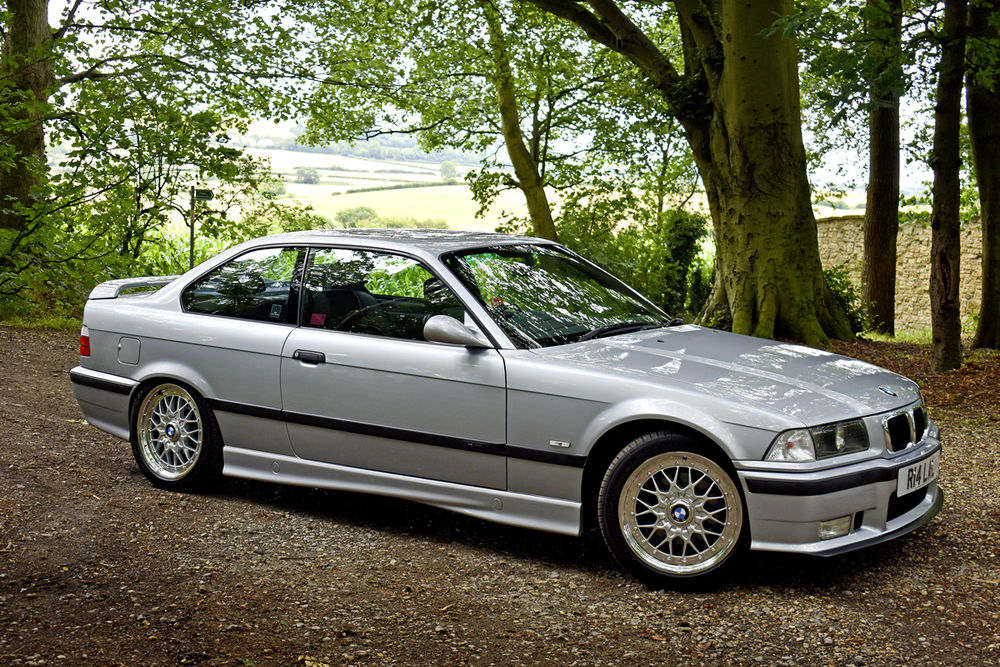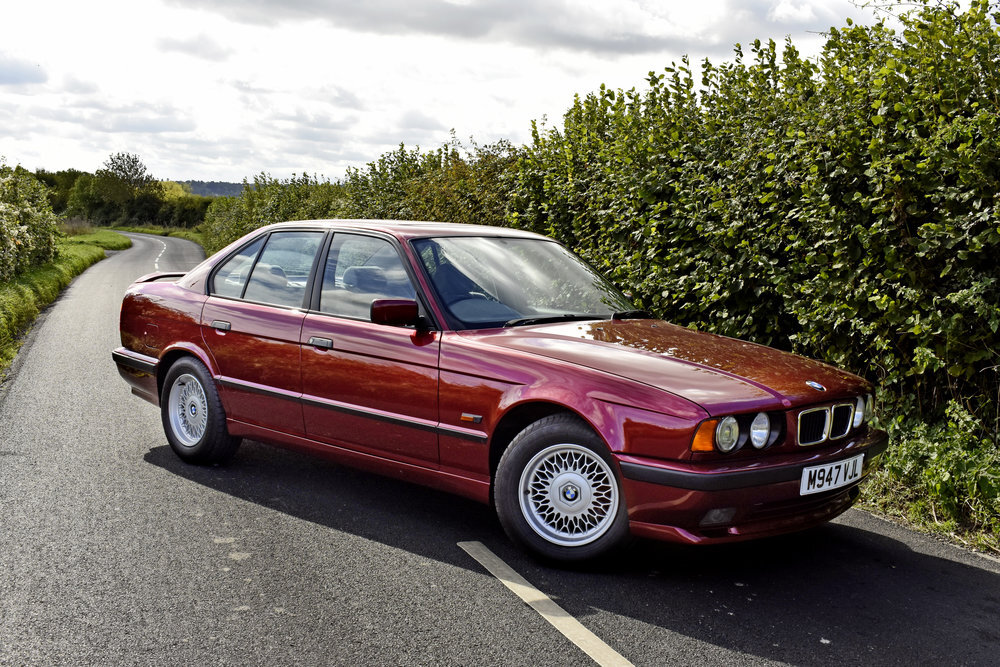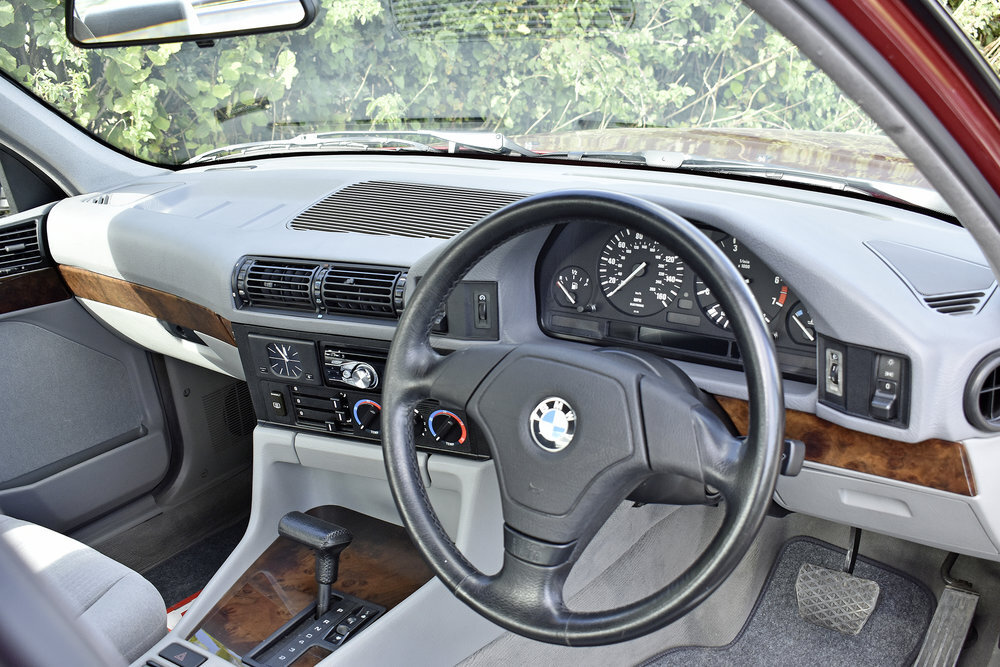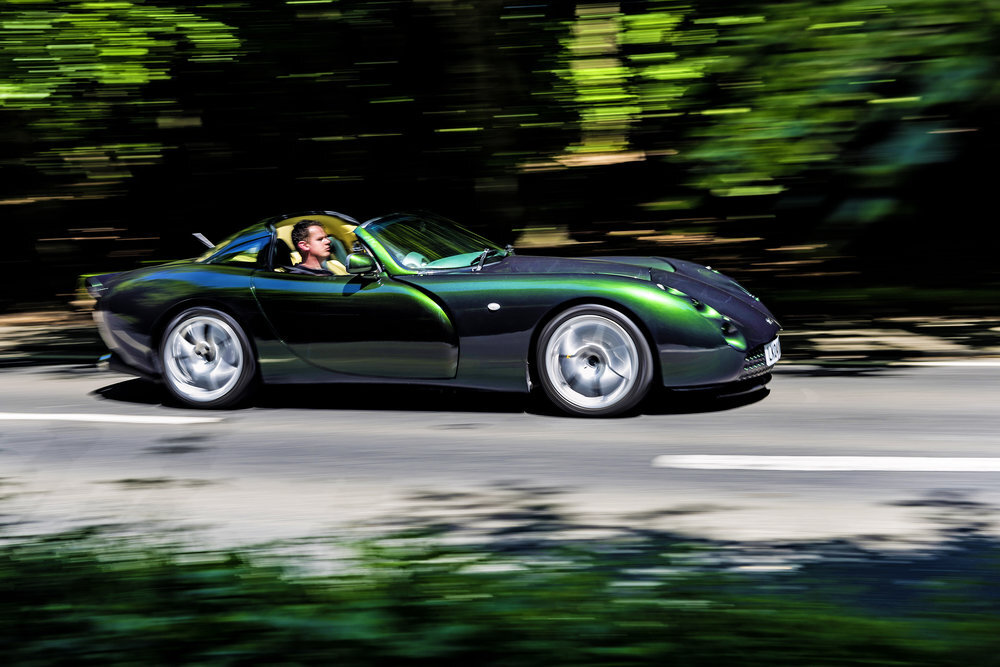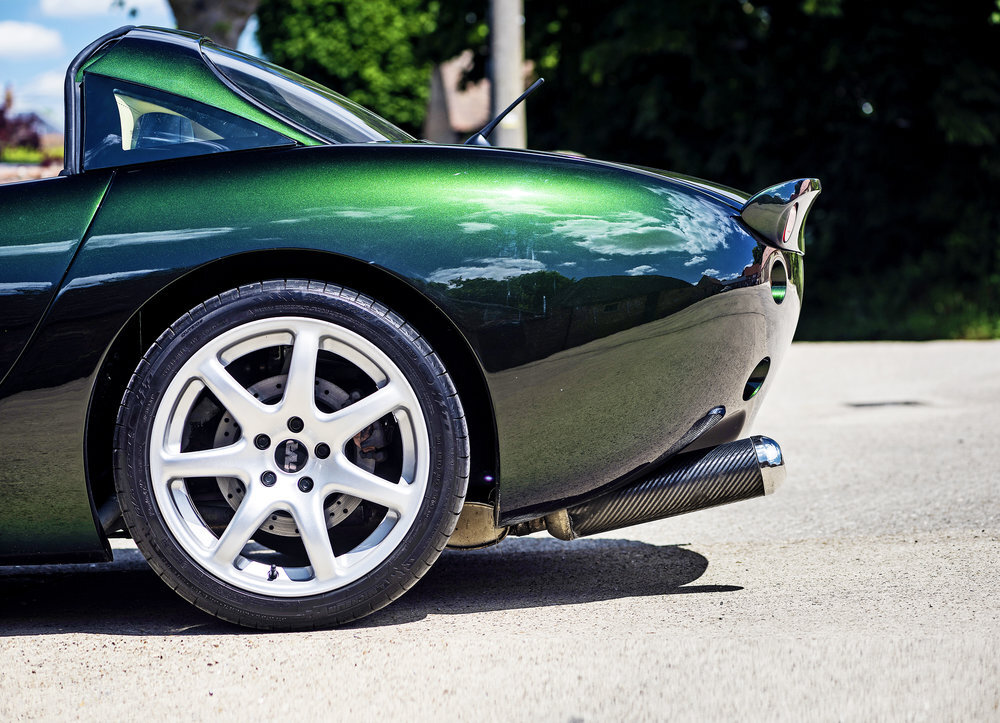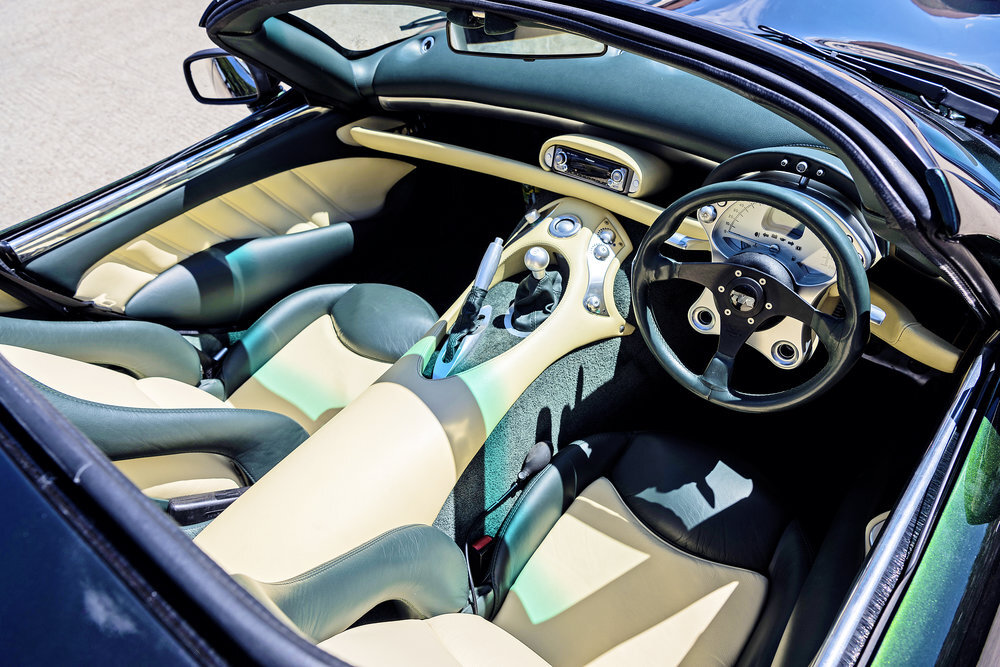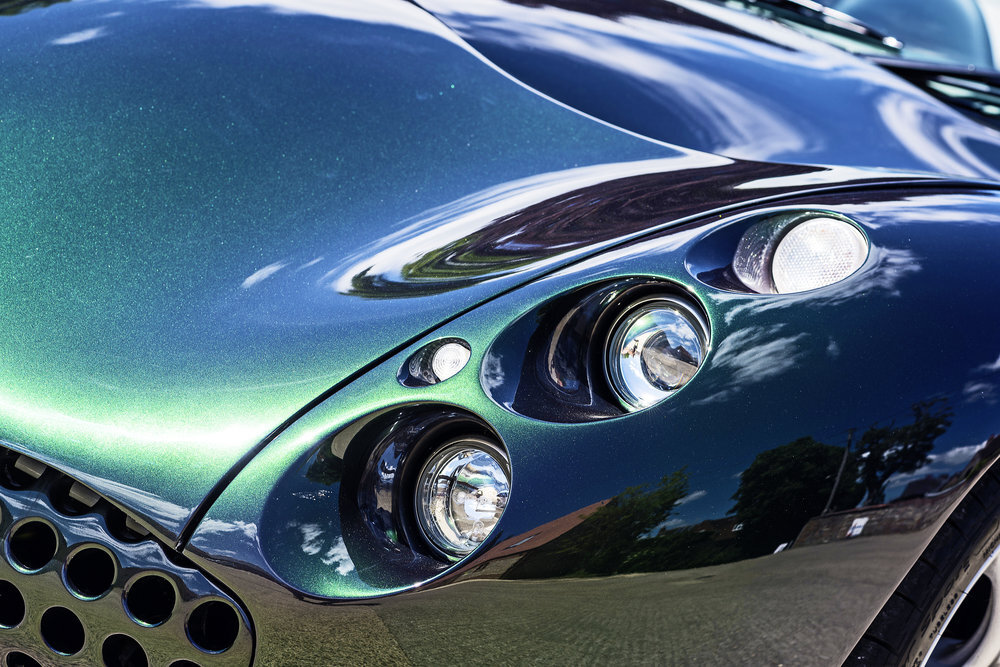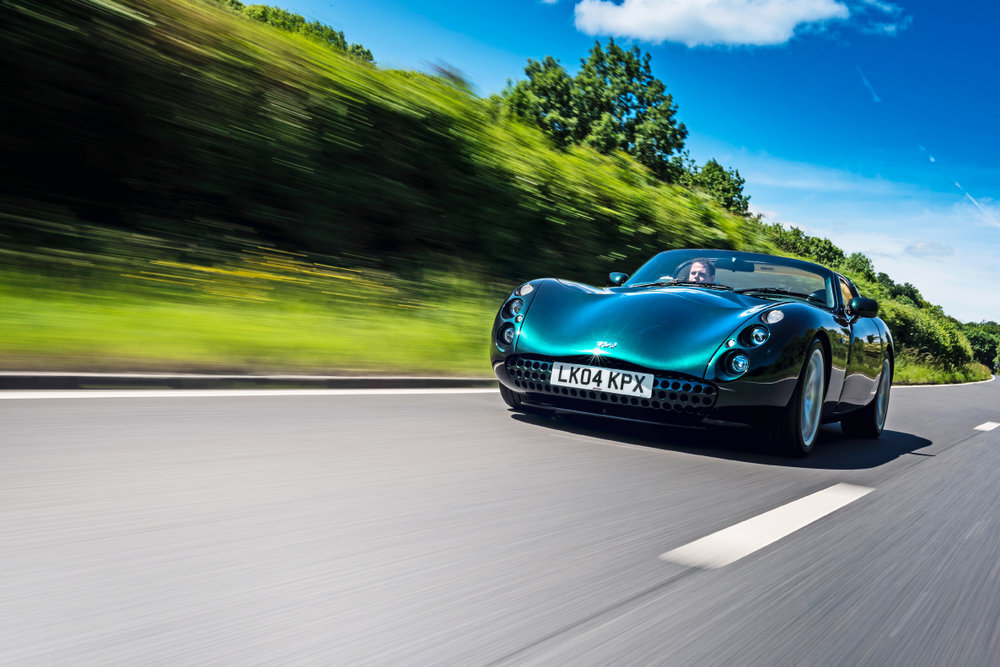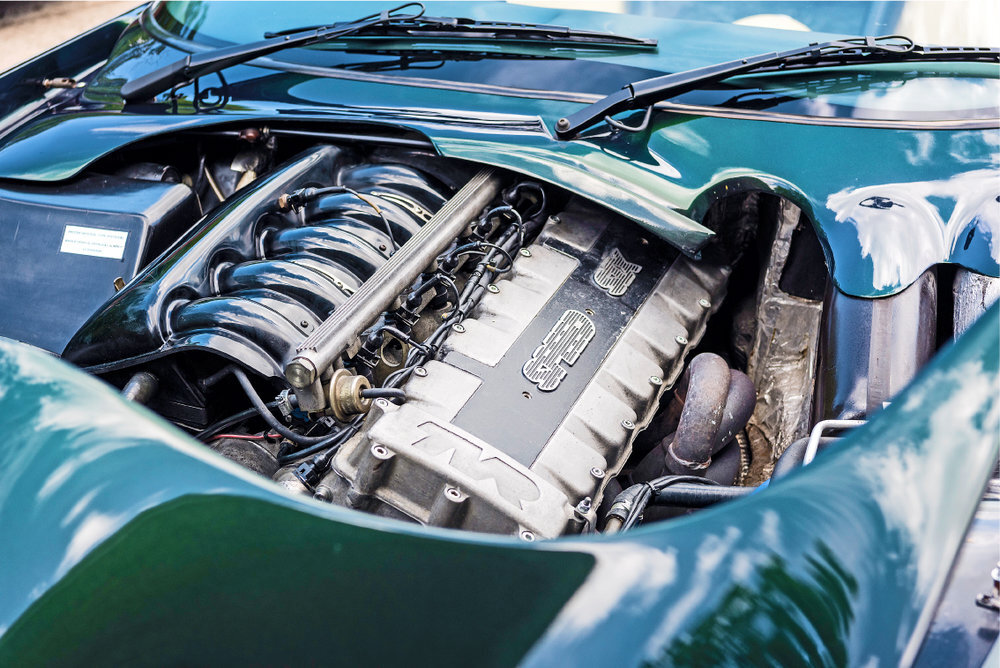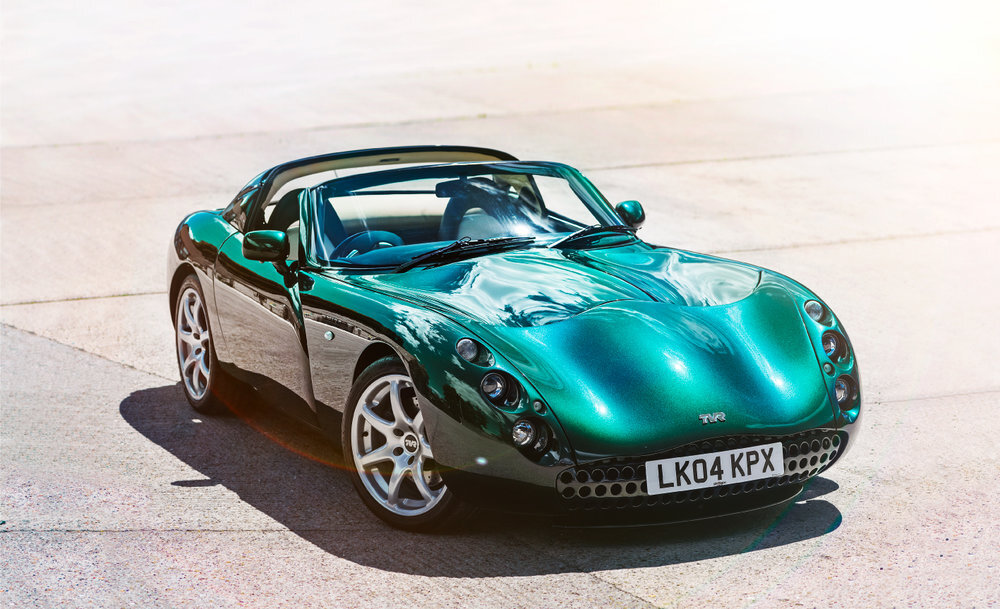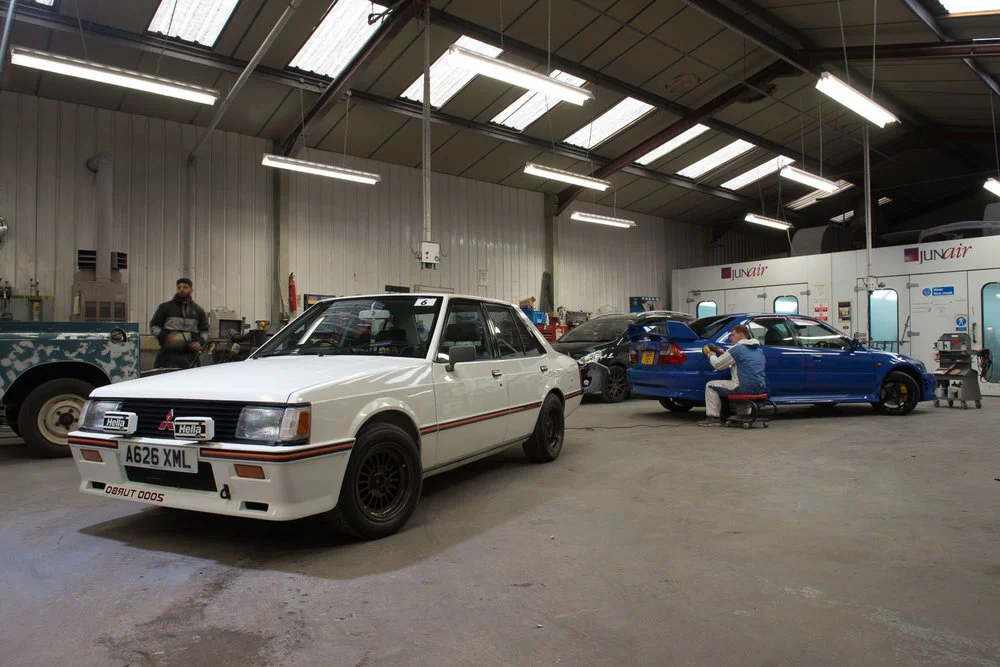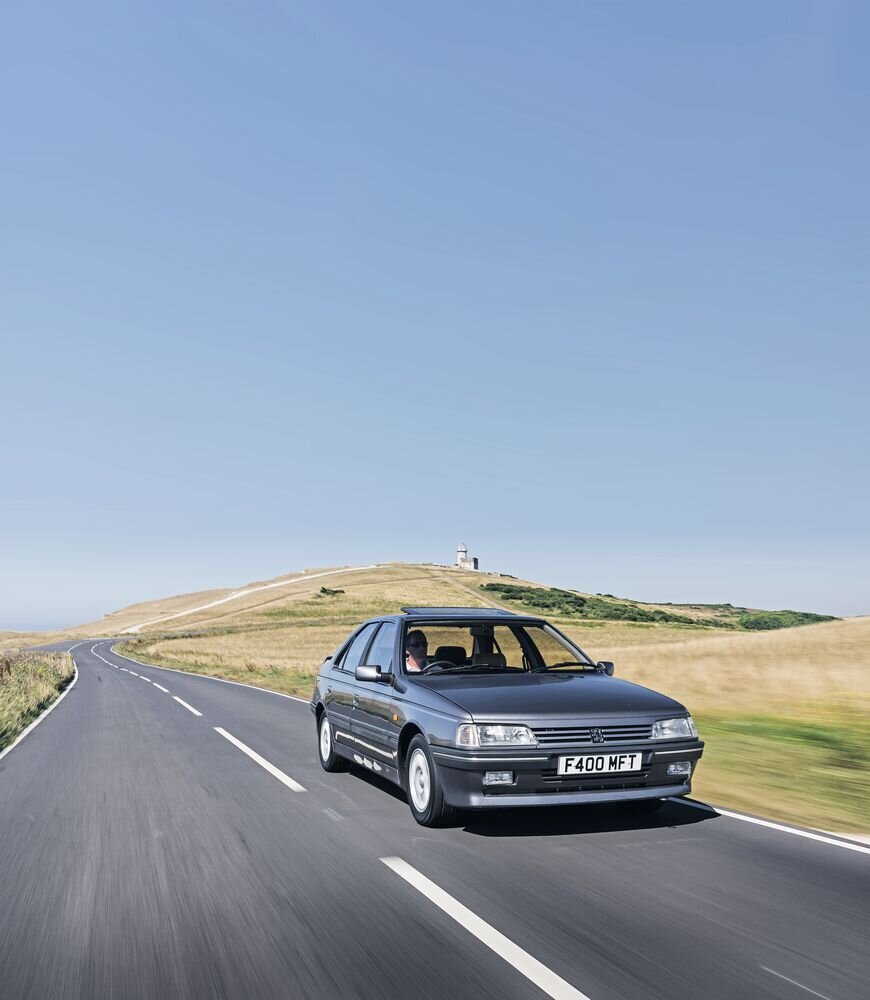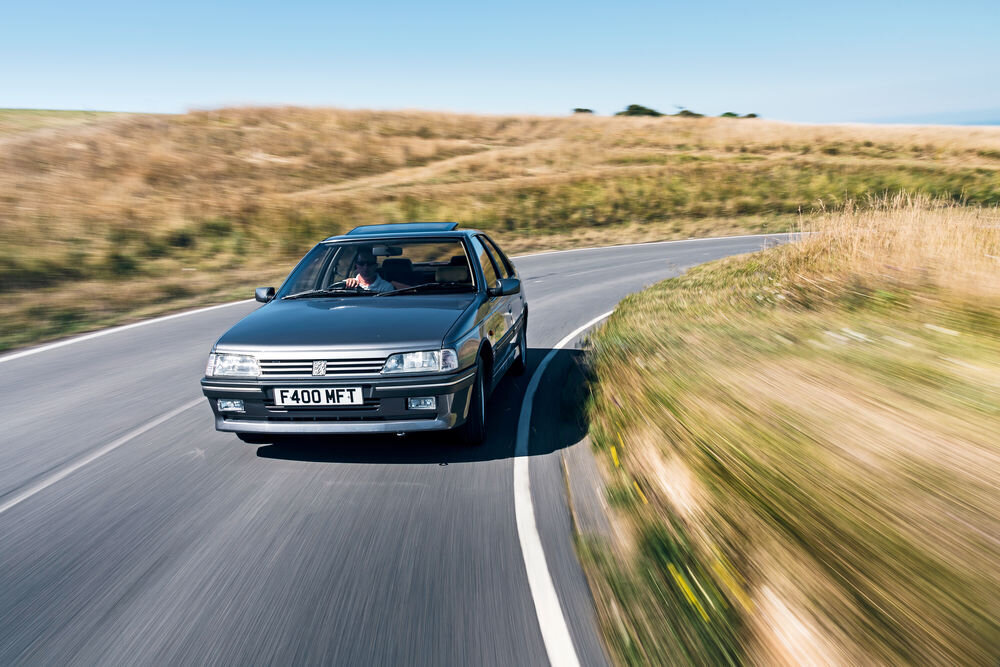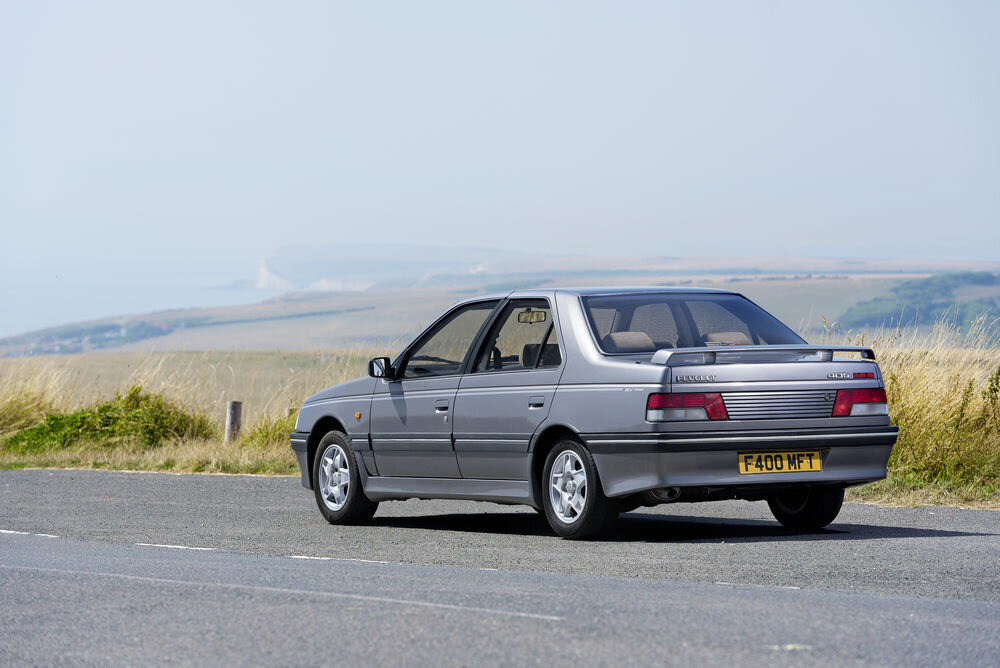The Jaguar XKR is maturing into a properly covetable 2000s Grand Tourer. Good cars don't stick around for long, and there's an XK for all – from refined cruiser to supercar-rivalling sledgehammer.
CLASSIC PEUGEOT REVIEWS
Alfa Romeo GT 3.2 V6
BMW 328I SPORT (E36)
Very few 328is are left in this condition – and Nathan finds this one deserves the cost of entry.
Cost New £35,383 Price £10,995
BMW 328I SPORT (E36)
Year: 1998
Mileage: 49,154
On sale at: Silverwood Cars
www.silverwoodcars.co.uk
Specifications
Engine: 2798cc, 6-cyl, DOHC
Transmission: RWD, 5-speed auto
Power: 190bhp@5300rpm
Torque: 207lb-ft@3950rpm
Weight: 1430kg
Performance
0-60mph: 8sec
Top speed: 144mph
Economy: 25mpg
Choose your BMW 3-SERIES (e36)
1990: E36 3-Series launched, originally just in four-door form.
1991: Two-door coupé launched.
1992: The BMW M3 joins the line-up, originally only in coupé form.
1993: Cabriolet version added; three-door hatchback Compact also joined the lineup.
1994: Touring estate version joined the range.
1994: The M3 is now available in saloon and convertible form.
1995: 328i tops the non-M range, using new M52 engine.
1998: Production of the E36 saloon ceases.
1999: Production of the coupe, Touring and Convertible ends.
2000: Compact production comes to an end.
Nissan 300ZX
In the current issue we tell the story of the Nissan 300ZX Z32 – the car that took on Porsche and beat them – but ended up being a forgotten hero. On its 30th birthday we believe it shouldn’t be forgotten – read on to find out how you can put one on your drive.
How much would you pay for a good manual Twin Turbo, and is it worth importing a fresh one from Japan?
UK manual Twin Turbos in good condition are few and far between and really hard to put a value on as they just don't come up. Rust was the biggest killer of these cars and while many Japanese models that have been here for a long period of time have long since turned into the ferrous ore from whence they came, UK ones got there a littler earlier and were scrapped when they were right at the bottom of their depreciation curve. Most good ones are generally owned and have been for a long period of time, although low mileage and/or good condition UK cars do occasionally pop up once every few years. On the other hand, if you're looking for a basket case as a project, you'll get a UK car every few months.
It is a similar story for Japanese-market models too, the influx of grey imports killed UK values in the early to mid-2000s, but many have been abused and there are plenty of NA models, which in my opinion aren't the ones to aim for. Go for the full red-blooded Twin Turbo. Some nice Japanese models pop up, certainly more than UK models, however the really nice ones are also owned and have been for long periods of time, but I'd say really examples pop up a couple of times a year.
Values are creeping up in Japan, but it still makes financial sense to look at a fresh import. Fresh Japanese cars are generally rust-free. Half the country lies in very mild climates and the other half that gets snow, doesn't get subjected to the yearly gritting onslaught that UK roads get each winter. There are still quite a few out in Japan and if you're prepared to wait, you can find exactly what you're looking for. Avoid 89 and 90 cars though as some early examples had issues with soft valves. Nissan addressed this with mildly revised cylinder heads and different valves for 91.
My pick of model year would be between 93 and 95, (although mine is a 91, albeit comprehensively revised) – they're generally the better-equipped cars. Early models have a rather dowdy tweed trim; 93 did away with that and the specifications were generally slightly higher. 95-97 did away with a boost gauge, 95+ had thinner carpets, less sound deadening and underbody protection. 97+ cars came without variable valve timing (slight torque change and a shift over to OBDII). Most late cars came without the fancy digital climate control and cruise control, even special models like the Version R.
In terms of differences between UK and JDM models, there's not much really. After 91 or 92, NMUK arranged for the Z32 to be shipped over with what was known as the 'lux pack' which is basically 'all options ticked' – this included heated leather as standard. If you select the correct JDM Z32, you'll find it is available with almost the same specifications. Everything else (other than some minor trim and glass tint differences, thicker ARBs and a transmission cooler on UK cars) is pretty much the same.
Prices for poor/non runners between £1000-£2,500
Prices for average TT manual models are between £2,500/£5k
Prices for good TT manual models are £5k+
Exceptional examples £10K+
NAs and Autos can skew the overall average values a little.
Finally – what's the best bit about a Z32?
For me, there really is no 'best-bit'. The car has the perfect balance of looks, performance and driver appeal. If, like me, you've owned the car for a considerable amount of time, it becomes very much a great social aspect if you get yourself involved. That goes for any Z. I'm heavily involved and on an international level and have seen and met some incredible things and people around the globe. Some of my greatest friendships have been forged by way of owning this car. It's a great hobby, it's a big deal socially, it's more than just a car, it's very much a lifestyle.
If you’d like to be part of the 30th anniversary celebrations for the 300ZX, or fancy talking to owners about ownership, the 300ZX annual meet is on Sunday 14th July at the British Motor Museum in Gaydon, Warwickshire. There’s a pre-event meeting on Saturday 13th at the Woodlands Grange hotel with a run out to the British Motor Museum the following morning. More details at https://www.300zx.co.uk
To buy the latest issue, with our profile of the 300ZX’s rise and fall, click below:
BMW 525i SE (E34)
Very few 328is are left in this condition – and Nathan finds this one deserves the cost of entry.
Cost New £28,700 Price £7995
BMW 525I SE (E34)
Year: 1994
Mileage: 22,900
On sale at: Stone Cold Classics
www.stonecoldclassics.com
Specifications
Engine: 2494cc, 6-cyl, SOHC
Transmission: RWD, 4-speed auto
Power: 168bhp@5800rpm
Torque: 164lb-ft@4300rpm
Weight: 1480kg
Performance
0-60mph: 11.3sec
Top speed: 126mph
Economy: 26mpg
Choose your BMW 5 Series (E34)
1987: The E34 5 Series is launched, the first 5 Series to be available in Touring form.
1988: M5 and 518i introduced; 520i updated to M50 engine family.
1990: 525i upgraded to M50 engine family; 4WD option.
1992: 520i and 525i engines upgraded to M50TU with variable valve timing. M5 engine grows from 3.6 to 3.8 litres; V8-powered 530i and 540i join the range.
1993: 535i engine dropped and 540i gets six-speed manual ’box.
1994: M5 gets six speed manual, 518i upgraded to M43 engine.
1995: 540i LE launched for UK market with just 70 built. Saloon production ends later that year; Touring ends in summer 1996.
TVR Tuscan S
The default dream car for many is a lipstick-red Ferrari or a lurid Lamborghini. But we reckon there’s not much that can beat a Tuscan S…
Words Dan Bevis Photography Chris Frosin
All this anxiety melts away as you ease yourself into the sumptuous cabin. The first thing you spot, of course, is that there are no door handles; the trick is to press the secret button under the wing mirror to pop the door open, then slide yourself down behind the chunky Nardi Personal steering wheel. Holy smoke, do TVR know how to do interiors! Just look at the thing – it’s bonkers. If you’ve ever had an absinthe-fuelled dream about lying in a verdant pasture with an antique clock while some benevolent soul pours melted Caramacs all over you, this Tuscan’s innards will seem peculiarly familiar to you. You find yourself cocooned in sumptuous creams and greens, a huge retro dial in front of you, hemmed in by a massive transmission tunnel studded with premium-feeling aluminium knobs and switches. The design hasn’t aged a day, it still feels über-fresh, and it’s this considered approach that instantly calms you down. This can’t be the terrifying, hairy-chested vandal that everyone makes it out to be. It feels like you’re lounging in one of those little fake living rooms in IKEA. Someone will probably be along with some meatballs in a moment. All is calm.
Calm, that is, until you fire up the Speed Six. Then the energy returns. You immediately step once more toward the precipice of terror. It’s worth pointing out that this particular car is no ordinary Tuscan S. It is, in fact, quite possibly the finest Tuscan S in the country. Lovingly curated by marque experts Str8six, it’s a low-mileage MkI finished in sensational Reflex Charcoal paint. They’ve hoiked out the motor and uprated the sprockets and bearings to tighten it all up, the interior’s been retrimmed in sumptuous new leather, and the nose has been repainted to eliminate those pesky stone-chips. The adjustable suspension has been optimised, it has fresh Michelins and it’s ready to rock. So… let’s do that.
A blip of the immobiliser button, then turn the key to the first click while the Tuscan self-checks. After a few seconds you’ll hear the fuel pump whirr, green-lighting you to twist the key further and fire the brawny six-pot into life. It catches instantly, settling into a calm but charged idle, crackling with potential energy.
The floor-hinged pedals are offset markedly to the right, your accelerator foot grazing the inner wing, so you find yourself pointing ever-so-slightly toward the front offside corner. But the snuggly seats (with lumbar support adjusted by a squeezy rubber bladder on a string) nestle you in so you’re totally at ease. Tasteful mirror adjustment buttons and rotary dials for the power windows are gloriously tactile. Thunk it into first, and brace yourself.
I’m under strict instructions to respect the car’s idiosyncrasies, not that I need telling twice. No more than 2500rpm is allowed until the oil temperature climbs above 60°. If the water temperature hits 100°, turn the damn thing off and chill out. So it’s with a certain degree of tippy-toeing that I pull out onto Oxfordshire’s winding country lanes. The targa roof panel’s out, I’m in a bona fide dream car, I’m happy to bumble. And by the time I eventually reach the first T-junction, everything’s up to temperature and ready to play.
This is just as well, as the Tuscan is immediately keen to remind me that there’s no traction control or anything lame like that. Exiting the junction on full lock with the tail wagging like an excitable labradoodle hammers home the fact that this isn’t a car designed to bumble. Perceptions realigned, I floor the throttle. What happens next is that bits of horizon which seemed tremendously far away are suddenly streaming past my wide eyes as the TVR thumbs its curvaceous Blackpool nose at the very fundamentals of physics. Holy hell, this thing is quick! I mean, quick enough off the line, but it’s at 4000rpm that it really comes alive, gargling like gravel and cream in a high-powered blender as the shift-lights flash and spur you on to the next ratio. The brakes, uncluttered by ABS, are staggeringly firm and immediate, allowing you to shear off vast swathes of vectors before exploiting the Tuscan’s trump card: its steering.
This car has many strengths – its mind-warping curves redefine the notion of automobile-as-art and the hefty gearbox is an utter joy to use – but it’s the quality of the steering that really defines the driving experience. Perfectly weighted, incredibly feelsome, it allows you to place the nose with millimetric precision at any corner angle, any speed. It’s so good it almost doesn’t seem real.
Naturally, there are two ways to steer this car. There’s a spinny wheel between your palms up front, but you can also steer with the two wheels at the back, and that’s a lot of fun too – the Tuscan S benefits from an LSD, and it’s always willing to let you slide the back end about at will. I’m enormously thankful that it didn’t rain on the day, as I’ve heard that can be a real crikey-I’m-in-a-ditch scenario, but on this hot morning it’s sticky tyres on bubbling tarmac. A visceral thrill at every turn.
Everything you’ve heard about the Speed Six motor is true. It’s hilarious, relentless, angry as a sealed jar of wasps in the sun. Kinda sounds like that, too. Part of the reason for that is the genesis of the Speed Six’s design; elements of the valvetrain can be traced back to superbikes of the early 1990s, and the individual throttle-bodies make it super-responsive – blip your right foot and it’s redlining in microseconds.
The crux of a TVR, as you’ve no doubt heard, is that it needs to be a bit tricky. These aren’t machines for people who want an easy time, they’re for those who want their effort to be rewarded, who accept that you get out what you put in. You need to be constantly on edge, worrying about the car – that’s part of the allure. I see the water temp gauge rising quickly past 90° as we cruise through Henley-on-Thames, so we head out to some open B-roads (negotiating the town’s speedbumps, no problem) and the car comes alive. But then another worry presents itself – working the Tuscan ever-harder down the lanes, a tremendous amount of heat starts to transmit through the gearstick, until the knob is almost too hot to touch. Which lends the act of changing gears a frisson of danger.
This isn’t a ‘worry’ at all. Not really. It’s character. It’s why people buy TVRs – they’re a bit mental, they’re not for people who care about fuel economy or being sensible. They’re for people who want to open the door by pressing a button on the dash, who want to pop their rear window out just for the sake of a breeze on the neck, who can’t abide choosing just one paint colour and want a car that’s four colours at once. On paper, the lack of electronic safety nets may seem risky, but in reality it’s all in keeping with the nature of an edgy car. The Tuscan S epitomises the concept of the driver’s car. It doesn’t need to be as silly as it is. But whoever daydreams about what they need?
The Modern Classics view
There are few cars that tick the dream-car boxes quite as comprehensively as Wheeler-era TVRs. Everything from the mind-warping, mushroom-infused, colour-shifting paint to the swooping, curvaceous, fairground-ride bodywork validates your every childhood notion that there really is no need to compromise. You can have it all. We all know the story of the Austin Allegro’s design, how it started out as something chic and rakish and was subject to so many management mandates and functional about-turns that it morphed into a total lame duck. Well, the Tuscan is the polar opposite of that way of thinking – a car engineered for staggering performance and hair-raising dynamics, with UFO-like aesthetics registering equally as importantly in those initial company brainstorms. It’s a car that never says no.
It makes for an intriguing proposition today, the 4.0 Tuscan S. While it’s indisputably in Modern Classics territory, it enjoys the unique hook of still looking and feeling entirely fresh and up-to-date. Wacky, outlandish styling is always a dangerous game, as it can make things age very quickly – see the Renault Avantime, Nissan Juke, Aston Martin Lagonda, it’s a long list – and it takes some time for the styling to come full circle and be regarded as cute again. But the Tuscan? The genius of its design is that it still looks brand new, and probably always will. It’s just so gorgeously weird. Hand a child a pack of crayons, say: ‘draw me a sports car,’ and they’ll sketch out a Tuscan. Say: ‘draw me a spaceship,’ and you’ll get the same result.
This is more than just a car, it’s the fulfilment of childhood dreams. At which point we can only reach the conclusion that, substantial wedge that it is, £40,000 is an alluringly low cost to make your dreams come true.
Specifications TVR Tuscan S
Engine: 3996cc/6-cyl/DOHC
Transmission: RWD, 6-speed manual
Power: 400bhp@7000rpm
Torque: 310lb-ft@5250rpm
Weight: 1100kg
Performance
0-60mph:3.8sec
Top speed: 195mph
Economy: 18mpg
Mitsubishi Colt Lancer EX 2000 Turbo
This rare Mitsubishi Colt Lancer EX 2000 Turbo was saved from the crusher. We find out why it was worth such huge effort
Words Ross Alkureishi Photography Alex Tapley
On full boost it’s easy to rush changing cogs and graunch the gears, but a steadier hand gives the synchromesh time to work, so you can enjoy ridiculous levels of unobtrusive, axle-tramp-free, velvety smooth thrust. Cheema’s words back at Spa Garage: ‘Everybody who drives one, buys one,’ ringing in my ears as I calm down and the Lancer gets in touch with its more docile side once again.
The original asking price is starting to make more sense, especially when you bring respective power outputs into play. The Lancer lays down a hefty 168bhp compared to its contemporaries: 143bhp for the BMW 323i, 110bhp for the Golf GTI and a paltry 96bhp for the Ford Escort XR3. Of course, the Blue Oval would later go down the turbocharger route with its RS Turbo, but still only manage 130bhp.
After a motorway blitz, during which the Lancer’s sheer pace surprises many a modern machine, it's off towards the Burton Dassett hills near Gaydon to put its handling charecteristics to the test. The Lancer features the same MacPherson strut front and trailing/semi-trailing located live rear axle set-up as a standard 1600 car, but with stiffer springs – hence the in-town harshness – and gas-filled dampers.
Point its snout into a bend and it feels remarkably composed with little body roll, which entices you to power-out early. Very quickly you graduate to shifting down a cog to stay on boost, and charging in harder – it remains firmly unruffled, whereas many front- and rear-wheel drive contemporaries would have you scrabbling to maintain controls and your personal composure. There’s a tendency to slight understeer, but unlike its straight-line experience no rapid change of character. It’s helped by precise steering and larger, Samurai sword-sharp disc brakes, which are ventilated at the front.
Taking in the view atop the Burton Dassett Hills Country Park, I’m a bit confused as the car feels far faster than its stated 0-60mph in 8.6sec stats and popping the bonnet reveals why – a non-standard intercooler and a BBW Motorsport sticker. From new, racing driver David Brodie’s engineering firm could supply upgrades from a Phase One set-up, which offered circa 200bhp, an intercooler, ECU upgrade, modified turbocharger and suspension and cost £1649. Phase Two added to that a gas-flowed and ported cylinder head, BBW camshaft and high-pressure fuel pump, and cost £2100. The big-money Phase Three gave you an engine rebuild, BBW forged pistons and a larger turbo. Cheekily, neither Martin or Cheema mentioned its extra perk. With the measure of the Lancer’s multi-faceted character, the return journey is an absolute joy. When the road opens up ahead there’s no point in resisting the temptation to boot it, and integrating a boost-gauge glance into your cornering technique greatly enhances your ability to skewer apexes. It’s an epic sleeper for a Sunday morning blast.
Back into town and it’s time to relax, give way to those of a more rushed disposition and, as the typhoon of performance falls away, allow the Lancer to return to a state of nondescript suburban Zen.
'We must have had a dustbin full of rust 'Poor parts supply and epic rust meant that the restoration took four years, ‘Bodywise it’s easier to tell you what I haven’t replaced on the body, rather than what I have,’ says Martin. ‘The car was scrap, but importantly it had an original and complete interior.’
The poor parts availability was a key factor in the restoration, as was the fact that he had a donor car. ‘We chopped up the black car and kept the good bits. You can't get new panels, so for other parts I re-fabricated them using the black car as a template.’ Rust is the enemy of this generation of Lancer. In his parts hoards Cheema had complete outrigger chassis legs that had never been on a car. ‘They were shot-blasted and painted, and three holes appeared before we got the chance to fit them.’
When the Lancer was first put on the ramp, the triangular plate joining the front panel, wing valance and outer drop wing valance simply fell off. ‘We removed the whole front end from the bulkhead,’ says Martin. ‘We must have carried a dustbin full of rust and scrap. The chassis was opened up and rebuilt inside, before being put back together and new front panel valances made.’
Martin wanted to ensure that any repairs were invisible, with meticulous attention to detail. ‘I had rear suspension turrets made, but they were hit and miss, so I made my own.’
Even where parts were available, ordering them was difficult because Mitsubishi require a parts number and records in Japan are held on microfiche. 'It's one of the reasons that the restoration took so long; it sat on my ramp for a year, while I looked for dampers. I ordered two from Mitsubishi, and they sent me one – the last in Japan.’ Cue an internet hunt, which turned up one in Coventry.
‘For convenience's sake, we fitted a spare Starion engine, but we still have the original,’ says Cheema. Getting the new engine running smoothly was hard. ‘It’d run fine and tick over, but then wouldn’t rev. All we got from Cheema was “it’s the fuel pump, it’s the fuel pump” for months,’ laughs Martin. ‘We tried changing the fuel pump but it still didn’t work. Apprentice Lewis Checkley found a loose wire coming out of the ECU, but to this day it’s still “the fuel pump”’.
Mitsubishi Colt Lancer Turbo 2000 (standard)
Engine: 1997cc/4-cyl/SOHC
Power: 168bhp @ 5500rpm
Torque: 181lb ft @ 3500rpm
Maximum speed: 124mph
0-60mph: 71.sec
Fuel consumption: 22-30mpg
Transmission: RWD, five-speed manual
HOW MANY LEFT? 14 (UK)
WHAT TO PAY?
Concours: £15,000
Good: £12,000
Usable: £8000
Project: £2000
Fiat Strada Abarth
Why this pocket exotic deserves to be remembered…
Words Nigel Boothman & Theo Ford-Sagers Photography Laurens Parsons
‘If you want a good one – a genuinely good one – the only way is to do it yourself,’ says Doug Blair. He’d been looking for a Strada Abarth for a while, keen to relive his fond memories of owning one when they were new. After examining the few he could find for sale, he realised that corrosion and deterioration were unavoidable.
So in 2010 he bought the best he could find. It was black, it came with an MoT, it was outwardly smart and okay to drive. Doug brought it to Emblem Sports Cars in Poole, Dorset. They’re used to restoring classic Ferraris, Maseratis and other exotica, and had worked with Doug before. He and Emblem’s boss Martin Chatfield came up with a plan. That plan sounds simple, but it’s remarkable for what it implies: have the car stripped, have the car repaired and painted, have the car rebuilt and trimmed. And not by just anyone – each job would be performed by a trusted specialist more used to working with Emblem’s usual upmarket stock-in-trade.
Andy Bowley and David Summers of Red Motori in Blandford Forum are best known for their work on classic Alfas. They began the stripdown in February 2011.
‘It was a good “on the road” car,’ says Andy. ‘But when we started lifting the carpets and removing the parcel shelf to get at the rear suspension turrets, we started to find holes.’
They also realised the extent of replacement parts that would be needed. All Strada trim, instruments, interior parts and switchgear is scarce; Strada Abarth 130TC stuff is like a decent joke at Prime Minister’s question time – rare to the point of extinction. Doug bought a basket-case 130TC, but it rendered fewer useable parts than he hoped, although someone bought the stripped remains, intending to restore it. Perhaps it, too, will return to the road one day.
Meanwhile, the black car’s denuded shell went from Red Motori to Mitchell Motors in Salisbury, a high-end bodyshop run by Andrew Mitchell. ‘It was rusty in all the places you could possibly imagine a Fiat being rusty in,’ says Andrew. ‘We blasted it with superfine glass powder at only 28psi; it was the most gentle method we could use that still had enough bite to remove the rust.’
Having created an ultra-light Abarth shell with enough holes to strain a giant pot of pasta, Mitchell Motors had to stitch it back together. ‘I think Doug found us a wing and a rear panel, but the rest was all made from scratch. That’s what happens here… if you bring it to me, beware, because it will be done properly. That means a whole heap of hours.’ Something in excess of 700 hours later, the perfect new steel and freshly stripped old metal was protected by much etch primer, a 3M two-pack polymer rubber coating on the underside, then lots of primer and rub-downs for the upper surface. Clear lacquer over that jet-black base coat was finished with 2000-grit wet sanding and then a burnish from some polishing compound.
Poor old Red Motori then had to work carefully around the most beautifully-painted Strada shell on the planet as they re-installed the engine and painstakingly built up the finished car. Doug likes the hunt for rare spares, so Andy Bowley would email him a list and parts would start to appear. Some, for safety’s sake, were new – brakes, seatbelts – but others like suspension components received a powder coat and went back on the car.
One fascinating challenge was created by those chunky Abarth sport seats. Doug, with great foresight, had bought a roll of peculiar black and red Fiat seat cloth in the 1990s. More than ten years later, he’d finally bought the car to go with it, and its front seats were tatty. Emblem sent them to ace trimmer Kevin Baggs, based in the same yard in Poole.
‘The centre panels of the seats were easily replaced with this fabric, but the plain black side-sections on the bolsters were harder,’ says Kevin. ‘In the end, I worked out that we could dodge between the pattern repeats on the cloth, even removing the red embroidered pattern if necessary, and trim all of both seats with this one roll.’
This is typical of the care taken over the whole car. What Doug ended up with is exactly what he wanted – not just a decent restored example or a nice second-hand survivor, but a perfect new one. And ever since it was finished, he’s been busy enjoying it. ‘It took me back to the 1980s,’ he says. ‘I could have upgraded it or changed it, but I wanted it to drive like they did back then. So it might not have modern brakes but it’s still quick, still a real handful. It makes you aware of what a breakthrough it was.’
Now it’s our turn. Doug hops in for the ride, big grin on his face, and we buckle up for a B-road brawl. ‘Just bear in mind there’s no rev limiter,’ he warns. Overcautious? Not really – in his defence, the last time he was a passenger in a Strada Abarth about 20 years ago, it ended expensively...
Before the off, some cabin logistics need attending to. These Recaros feel just as solid and snug as they look, but they barely fit in the car. The flat base doesn’t sit flush with the creases in the floorpan, and you're forced to set the seat and wheel rake adjustment to their furthest extremities to make room for knees and thighs. But once you’re settled it all feels quite sensible and the instruments and switchgear are drawn out close to eye level in long, regimented order. The wheel and pedals are a little offset, without feeling cramped.
On the move the clutch can throw you off. It’s deep and soft, and it's easy to misjudge the biting point when heading for second. Synchromesh on second tends to be short lived, says Doug, and it's easy to see why. But when you get it right, you’ll have a huge grin on your face. The ZF’s five tightly-spaced ratios are perfect for attacking tight, twisty roads.
All the torque comes well before the red line, so there’s little risk of popping the engine even without a rev limiter. It’s very keen off the mark, lunging out of junctions and delivering a gutsy upsurge of midrange power with a big, bestial yowl. There’s lots of noise, all engine rather than tailpipe – unsubtle but huge fun.
Once you’re rolling, the unassisted steering is perfectly weighted and offers a fairly responsive turn-in, neat at first with an extra little flick of attitude when you lift the throttle. And enthusiastic cornering will certainly make you glad of those bucket seats; the Abarth’s stiffer springs help compensate for the engine’s extra weight, but still allow a fair amount of body roll. Grip and balance don’t need to be pushed to the limits to have fun, though it’s easy to feel egged on to try harder. ‘You can see why my last one got written off,’ says Doug. We think he’s still grinning...
As it’s a hatchback, it seems fitting to test its practicality by getting into the back. This involves grappling with the Recaros again and contortion of the hip in order to slot yourself in. When attempted by 6ft English blokes, it’s a recipe for pain and laughter, followed by inevitable affection for this bonkers little car.
It’s an old-school slayer of automotive greats, a weird marriage of the daft and the practical, and as flawed as it is wonderful. But what about the elephant in the room – the one munching bales of £50 notes?
‘Having done a few Maseratis, I know the levels involved to get a good car,’ says Doug. ‘It got a bit out of hand, but my heart ruled my head. There are so few around, and no really good examples, so why not?’
The Modern Classics view
This money-no-object approach isn’t possible for every hot-hatch restoration, but it seems appropriate that it should have happened to one of the rarest and most eccentric of the breed. A good Strada Abarth could be the 1980s equivalent of an Alfa Giulia Sprint of the late 1950s and no one bats an eyelid about throwing money at them.
That’s not to say Doug Blair’s expenditure is about to become a sound financial investment. That was never the point. What he’s done, apart from building himself a wormhole back to 1985, is to nail down the future of one small but exciting piece of motoring heritage.
Why it’s the final countdown if you want a Peugeot 405 Mi16
This hens-teeth Peugeot 405 Mi 16 reveals why it was one of the era’s greatest Q-cars, even if it's overshadowed by its GTI brother. Every once in a while, a manufacturer gets it bang-on the money with a car.
Peugeot 405 MI 16 specs
Engine 1905cc, 4-cyl, DOHC Transmission 5-speed manual Power 155bhp@6500rpm
Torque 131lb-ft@5000rpm 0-60mph 8.6sec Top speed 137mph Economy 31mpg
This is a great shame and also quite a feat, given the Mi 16’s healthy production run from 1987-1992. In fairness, it’s unanimous that the 405’s all-aluminium 2.0-litre is an absolute peach. If you’re more partial to a crisp, hard-revving twin-cam than anything forced-inducted, then the all-aluminium XU9J4 has to be on your bucket list of motors to experience. But, this doesn’t mean it’s better off anywhere other than in the car it was fitted to in the first place. As a package, the 405 Mi 16 is sublime – mixing big-saloon practicality with giggle-inducing handling and looks that don’t scare old ladies, but will get you nods of approval from those who know.
It’s a pretty accurate assumption to make that a lot of flashier motors got shown up by Mi 16s back when they were new. The owner of this fine example tells me it’s something he still takes great joy in today, because – to use the tired cliché – it’s a right wolf in sheep’s clothing.
Shaped and styled by the fair hand of Pininfarina, the 405 manages to make a traditional ‘three-box’ saloon shape elegant. It’s a fine car to behold, and that’s before taking into account the cheeky extras that the Mi 16 included – deeper front and rear bumpers with the former sporting two rectangular fog lamps, deep side cladding, a raised boot lid spoiler and racy five-spoke alloy rims. All these cues come together to form a purposeful, sharp look, without being in any way crass or obvious. They merely make you question what might lie beneath the skin of such an otherwise common-or-garden car, with the only confirmations of the 405’s performance bloodline being the black and scarlet Mi 16 boot badge and subtle pinstriping, ending with a ‘16v’ motive on each rear flank.
Popping the door and lowering yourself into the waiting sports recliners, everything seems very civilised and comfortable. More red and black colour scheme in here; the door trims and sports seats feature a fine chequered pattern which – as with the rest of the car’s aesthetic – mix flair with a reined-in, grown up feel. A skinny centre cubby box sits too low for elbow-restage on long journeys, and scratchy, brittle-feeling plastic makes up much of the trim and switchgear. It’s definitely French.
A large dashboard console sweeps across in front of the driver, housing a clean, logical instrument cluster. There are no lairy white dials here, but an oil temperature gauge is another notable addition. And a rev counter – with a 7k redline?! Curiosity well and truly peaked. The chunky three-spoke steering wheel allows a clear view of the dials, and the gearknob is placed well to hand.
Sparking up the engine, revs rise briefly before settling into a hushed but slightly off-beat idle. Getting the 405 rolling is easy; the clutch is surprisingly light and forgiving, and working up through the gears gives no indication of any naughtiness. Steering is power-assisted but gives good feel, and the brakes respond obligingly, if slightly numb on the pedal.
With the Sussex coastline in view and ribbons of fresh tarmac ahead, it doesn’t take much encouragement to get the 1.9’s sixteen valves opening and closing a bit more frantically. Just above 4k is where the XU gets interesting; engine notes change and induction noises become more pronounced as that tacho needle strays temptingly close to the red bit. Rowing up and down the gears quickly becomes second nature, and before you know it, all concentration is on upshifting just before the limiter bounces, then pegging the pedal again as soon as the next cog’s engaged. Sixty mph is easily achievable in second gear, and the shriek of the motorsport-derived lump is addictive. Engines don’t sound like this in modern cars. Not visceral, raw, unmistakeably naturally-aspirated. The long runners on the Mi 16’s inlet manifold and big-valve head can be thanked for its top-end eagerness. It rushes to the red line, then gets there and instantly begs for more.
Even on this early car’s 14-inch wheels, there’s very little sidewall roll into corners. The 405 is all-independent, and the suspension does a superb job of flattening out imperfections while also keeping the body flat; threading a car as large as the 405 through tight bends and switchbacks shouldn’t be anywhere near as easy as it is. A big contributing factor to this is the stiffness of the shell – high door sills and a shallow bootlid help keep the body rigid, allowing the front struts and rear torsion bars to do their work. What’s also immediately apparent is how delightfully light the 405 feels. The car tips the scales at 1108kg, which isn’t much at all for a spacious 5-seater ‘loon with a half-decent boot. You’re aware that you’re piloting a big car of course, it just fools the mind because it doesn’t behave like one at all.
Once used to the slightly dead feel of the brake pedal, the Mi 16 can be set up for corners a treat. Downshift into the power band, quick brake dab, pitch it in, marvel at the lack of understeer, forget you’re driving a family saloon, pin the throttle and ride out of the bend in a fury of tyre chirrup and screaming twin-cam. Then inconspicuously pick the kids up from school and do the weekly shop.
The Modern Classics view
As fast, range-topping saloons go, the Mi 16 is up there with the best of them. Having one on your driveway now is bound to invite more questions than admiring stares from onlookers, but once you get to understand the car properly, it’s hard to ignore how right Peugeot got it.
The star of the show is without a doubt that engine; but the rest of the car works so well around it. Buying one of these rarities now is not only going to cost a pretty penny, it’s going to be bloody difficult as well. They don’t come up often and when they do, Peugeot buffs tend to snap them up quick sharp without too much haggling. Projects have come up recently for around £1500, but a well-sorted 1.9-litre car with its original wheels and history will set you back between four and six grand.
While this may come as a disappointment to many who want the chance to own a 405 Mi 16, it’s still a bargain compared to the more common and borderline extortionate 205 GTI. Moreover, it’s reassuring to know that any of these near-extinct lions that do change hands now will almost certainly be saved, repaired and enjoyed, rather than butchered for their hearts – which can only be a good thing.
ASTON MARTIN DBS REVIEW
An Aston Martin DBS requires careful buying - let CCFS be your guide...
Settling into the cabin of a DBS makes you appreciate the bespoke nature of an Aston Martin. It’s very wide, a lucky accident of the car’s design originally being created as the four-door luxury Lagonda saloon, the DBS being shortened but not narrowed to create a coupé body shape. Individual stitches in the dashboard covering, seats and soft furnishings are a reminder that here is a car created without the uniformity of mass production. The Tadek Marek-designed six-pot burbles into life, yet needs warming thoroughly before you can drive the car. An Aston isn’t a car to thrash from cold.
Cars of this era, size and power that run on wire wheels are unusual, yet those wires also add a vintage aura to the car. Brakes and steering combine to allow sufficient control for cruising, but the car’s happiest gait, which is over the legal maximum, is helped by the over-riding weight, at which pace the dampers soften slightly and give astonishing ride comfort. True, the de Dion rear axle can be upset by poor road surfaces and the all-round discs can feel wooden, but are easily cured. Get out and drive it!
VITAL STATISTICS
Aston Martin DBS
Engine 3995cc/6-cyl/DOHC
Power (bhp@rpm) 282bhp@5750rpm
Torque (lb ft@rpm) 290lb ft@ 4500rpm
Top speed 140mph
0-60mph 7.2sec
Consumption 13mpg
Gearbox 5-spd manual/3-spd auto
WHAT TO LOOK FOR
BODYWORK & CHASSIS
Wire wheels fitted to DBS Astons are close to the combination of weight and performance they can bear. Check for broken spokes and spline wear as on any wire-wheeled car. Original wheels may have already been replaced, but avoid cheap new-looking replacements. Assure yourself they are up to the car’s weight and performance specification, or budget for a conversion to DBS V8 alloys or upgrade to a premium make of current, new wheels from an established maker such as Borrani.
Examine the extensive glazing for traces of delamination on the windscreen. Check rubbers for traces of overspray. Paint repairs are often harder to detect on higher-end, bigger margin cars, especially when values are accelerating. Yet fresh paint may only be disguising deeper problems not adequately repaired.
Check for accident damage and panel misalignment. The front cradle carries engine, front suspension and steering along with the bodywork extremities. The weight of the car means the rear should also be checked for details showing crash damage.
The rear wheelarches are often where the first traces of corrosion can be seen, so check for recent work to cover dodgy arches.
Check the chassis and bodywork minutely for corrosion. Examine for rot in the sills, pedal box and rear suspension mounts. Look for signs of electrolytic corrosion between steel components and alloy skinning over the whole car inside and out.
Blocked drain holes can lead to damage within doors, sunroofs and boot area. Also check for corrosion inside the fuel filler doors. Corroded cars are, as a general rule, best avoided – buy the best car your budget allows.
ENGINE
Straight-six engines should have colossal oil pressure. You should see approaching 100psi on the gauge at 3000rpm. The units have a reputation for overheating and, as an alloy motor with iron liners, can be prone to sludging, especially around the rear three cylinders. This is owing to a slack spot in the water circulation. Coolant should be fresh and clear, with adequate antifreeze to protect the block from internal corrosion and sludge build-up.
If you are looking at a car with a re-built motor, check the invoices to see if the liners have been lifted for any cleaning.
Beware cars described as ‘needing a tune-up’. If an owner has not had the wherewithal to keep it in tune, then he’s probably skimped elsewhere, or alternatively, there is something much more major wrong with the engine than a mere tune-up could fix. Engine oil should be fairly fresh, with no carbon build-up internally.
RUNNING GEAR
Chrysler Torqueflite three-speed auto gearboxes can be simple and moderately cheap to repair, but they don’t like long periods of inactivity as the brake bands can delaminate from the backings when condensation forms in the gearbox from short runs. The dog-leg ZF five-speeder can be noisy in use, though seldom fails, as it is extremely strong.
And finally be aware that clutch wear can be high, so consider that when looking over the car.
BRAKES
A known DBS weak-spot concerns the differential and its seals. The inboard rear brakes can cause localised hot-running, which thins the diff oil and can cause leaks. The seals also degrade with the proximity of the brake heat, compounding the problem. Leaking differential seals can be prohibitively expensive to repair, and running with low oil levels can shorten final drive life drastically.
INTERIOR
Interior trim generally wears well, and is made from good quality materials. However, beware re-trims which are not as well made as the original. Repairs are simple, though costly. Electrics, instrumentation and switchgear are simple, although electric windows may be slow or sticky in operation.
OUR VERDICT
For too long, the DBS has been an unloved, formerly glamourous car hijacked by the newer, twinklier, and more coverage-worthy V8 in all its iterations of be-spoilered, high performance furore. And as the oldest car from that era of Astons, it has lagged in value and been seen as a curio by restorers and classic fans alike.
Only now is the car getting the recognition it deserves as the sire of a new generation of Astons for the 1970s and beyond. And for that reason, good DBSs should be prized beyond compare for their design purism and relative affordability. Yet buyers beware. A DBS will cost as much to restore as a DB6, practically to the penny, yet be worth a fraction when complete. So next time you see a beautiful DBS on the road, remember, it’s only the truly heroic DB fan who will be running one.
William Towns’ wonderful shape for the DBS captured the late 1960s enchantment with clean crisp lines and an intelligent-looking update to the Aston grille design incorporating quad-lamps. It was a radical departure compared to the curvy shape of the earlier DB6, and instantly made the older cars look out of date. The 1967 introduction of the DBS was hailed for its de Dion rear suspension, a departure from the DB6, but the additional heft of this larger car quashed performance, so the straight-six DBSs are more leisurely performers than forebears that are fitted with similar spec motors. As a classic, this is less of a problem, as you’re not buying into the latest performance motor car, but accessing what the marque stands for.
Prices are strengthening and, should you want one, now is the time to buy a captivating GT with full-sized seats giving touring capability for four. And doesn’t the shape look pure? The suave good looks of the 1960s lived for a long time as the updated V8, yet the earlier car is still the purest. Buy right and it might still reward with appreciating value, too.
FERRARI TESTAROSSA REVIEW
Ferrari’s 1984 Testarossa is the embodiment of the breath-taking supercar. It’s also one of the most svelte and seductive performers from the stable of the prancing horse, offering an accessibility and ease of use which has sometimes earned it the criticism of being a poser’s car.
You can’t deny that, after the initial slightly ungracious entry to the 45-inch-low cabin, there is little resistance to your setting off and just driving, save for a baulking gear change when cold. But its abilities run far deeper than merely cruising the trendiest streets in town.
You immediately notice the Testarossa’s willingness to trot smoothly along in traffic, just on tickover. At slow speeds, the steering lets you feel the machine’s size and weight (60 per cent of which is located to the mid and rear), but it’s never intimidating. Still, you’re aware that the nose drops immediately out of sight and those straked sides swell out to more than six foot in width at the back.
None of that will deter you – there’s something terribly compelling in the way that, as you gently press your right foot forward, the power rolls up out of nowhere. There’s no jerk or shove – 2500rpm just appears under the bright orange tacho needle and climbs, the muted burr of the engine (which sounds like a robot playing a didgeridoo at walking pace) warming into a darker growl.
There’s a slight tensing across your shoulder muscles as you push the lever through the gate claws, encountering heavy resistance followed by a sudden submission and that silken power immediately there again – any gear, any gradient. Suddenly you realise that your perceived 40mph is actually 70mph and the Ferrari Testarossa is limbering up, dismissing bends with only slight inferences of your forearms and sensitive control of the pedals.
Finally, on long straights, the growl gives way to the wailing of the exhaust as the thing sucks the road beneath it, turning it into a streaking grey blur. You’ll back down way before the Ferrari does.
There are times where you might want the more guttural sound and shove of its older sister, the 512BB, or the ten-tenths mechanical communication of deadly rival the Lamborghini Countach. But as you drive a Testarossa, catching a glimpse of the sweeping lines in reflections and dipping into that towering ability to cover ground so quickly and effortlessly, you realise that probably no one has created a more capable or charismatic sports tourer.
TRIUMPH 2000 REVIEW
Spacious and comfortable, the 2000 was deservedly popular and is still great value today...
Design work started in 1944 following Standard's wartime purchase of Triumph, with the objective of producing a saloon and sports roadster, using a common engine, gearbox and similar running gear. The 1,776cc overhead engine and gearbox which Standard had been supplying to Jaguar for their 1 1/2 litre saloon was initially employed using the existing Flying Standard rear axle. The chassis featured an all-new design which included independent front suspension and comprised of two large-diameter steel tubes joined by cross braces. With a shortage of post-war sheet steel, the main body panels were of aluminium alloy, the bodywork being styled by Standard's Frank Callaby, who included a dickey seat, similar to the design of the pre-war Dolomite Roadster coupe. Launched in March 1946 alongside the razor-edged 1800 saloon, the larger engine was introduced in 1948, featuring the 2,088cc, 3-speed gearbox together with a new rear axle, which came across from the newly-introduced Standard Vanguard. Power increased from 65 to 68bhp, raising the top speed of the Triumph 2000 from 70 to 77mph.
VITAL STATISTICS
Triumph 2000 Mk 1
Engine 1998cc/straight six/OHV
Power 90bhp@5000rpm
Torque 117 lb ft @2900
Top speed 93mph
0-60mph 13.5secs
Economy 25mpg
Gearbox 4-speed manual/3-speed automatic
WHAT TO LOOK FOR
The biggest concern with a 2000 is corrosion, and while poorer quality steel makes facelifted Mk 2 models more susceptible all will need careful checking. The sills are the first place to look as rot here can easily spread to the floor and chassis outriggers with expensive consequences. As it is, their complex three piece construction can lead to bills of £1000 per side for replacement. Blocked drain holes are a common cause of problems so check them thoroughly, especially if there’s evidence of recent bodywork repairs or restoration, and take a good look at the double-skinned front wheel arches, the door bottoms, and rear valance.
The boot floor also rots out, and it’s worth lifting the rear suit cushion if possible to check the state of the metalwork beneath. Front wing seams are another weak point and make sure you examine the A-posts and screen surrounds as repairs here are tricky and costly. Finally, take a good look at the shut lines and the alignment of the front-hinged bonnet as both are good indicators of overall condition. Finding replacement panels can be an issue although club member, Lloyd Reed, is now re-manufacturing previously unavailable items (see specialist contacts.)
The straight-six engine on the other hand is tough and reliable and should manage 100,000 miles plus before a major overhaul is needed. Replacing the canister oil filter with a screw-on type is a good move and it’s worth checking for signs of head gasket problems along with any issues affecting the crankshaft thrust washers. It’s a common Triumph problem that can lunch the engine if they drop out, so watch for excessive play at the crank pulley as the clutch is depressed. Keeping the twin Stromberg carburetors of early models in tune could be tricky and they may have been replaced with a more reliable set-up by now, but the Lucas fuel-injection on the PI shouldn’t cause trouble today – the system is well understood by specialists and should be fine if properly set up.
Noisy layshaft bearings can afflict the 4-speed manual gearbox but it’s otherwise trouble-free. And if you suspect overdrive problems – the Laycock ‘A’ unit was replaced by the ‘J’ type after 1972 – wiring problems or a low oil level may be the cause rather than anything more major. The Borg Warner automatic is strong and proves reliable with regular fluid changes. One area worth checking though is the differential as leaking oil seals could have allowed it to run dry, while the raised ride height of post-May 1974 models could lead to cracks in the subframe bracket at the nose of the diff. Lastly, listen for clonks signifying wear in propshaft and driveshaft UJs – parts aren’t expensive but replacing them all is time-consuming.
There’s not a great deal to worry about with the rest of the running gear, so it’s mainly a case of checking for wear and tear or neglected maintenance. Suspension bush replacement can be labour intensive while the rear spring top mounts can rot where they meet the inner wings and are tricky to fix. Otherwise, just watch for sloppy steering caused by worn rack mounting bushes and noisy rear wheel bearings as replacement requires the use of special tools.
Some interior trim parts are scarce now so you’ll want to make sure everything is complete, and it’s worth checking for problems with collapsing seat bases, tears in vinyl or leather trim, or damaged wood veneers. The brushed nylon seat material used later wears well though. Tired interiors can obviously be re-trimmed but the cost can soon mount so budget accordingly if things are shabby. It’s also worth checking the state of the wiring as connectors and insulation could be showing signs of age, and if the dynamo on early cars has been swapped for an alternator, so much the better.
AT THE WHEEL
The sharp Michelotti lines impressed visitors to the 1963 London Motor Show where the 2000 was launched, and the Rover P6 rival would go on to become a strong seller for the company. After the introduction of a stylish estate in 1965, buyers were offered a Mk 2 version in 1969 which brought a new dashboard design and seats amongst other changes, and then a further facelifted model in 1974. All told, around 270,000 examples were sold in total and driving one today makes it easy to see why so many people fell for its charms. The first thing you notice is just how roomy a 2000 is, and if you’re after a family-sized classic this British saloon will certainly fit the bill. And there’s always the lure of the estate if extra luggage capacity is a priority. There’s plenty of comfort on offer too, and while the improved seats and revised dashboard of the Mk 2 lift the interior ambience, all models prove excellent long distance machines. Cruising ability is certainly helped by the addition of the optional Laycock overdrive but even without it there’s decent refinement on offer, while the smooth, torquey six-cylinder engines keep things from feeling strained. The earliest models weren’t especially quick though, the 90bhp unit ensuring that 100mph remained out of reach with the 0-60mph dash taking a relaxed 13.5 seconds. Still, if you want pace you need to look to the fuel injected 2.5PI model that joined the range in 1968 which managed the same acceleration benchmark in less than 10 seconds. Smooth manual or automatic transmissions help the 2000’s easy going nature, and the rest of the controls are equally slick and well-weighted, although power steering is a useful addition if urban miles are on the cards. But whether in town or on faster roads, a well-judged ride keeps the worst intrusions at bay while the handling is safe and predicable rather than sparkling. The latter wouldn’t have bothered too many buyers at the time though and it doesn’t matter much today either in light of the big Triumph’s other attractions.
OUR VERDICT
Comfort and usability lie at the heart of the 2000’s appeal, and if family-sized classic motoring is required then look no further. Sharp styling and smooth driving manners add to the appeal, and while you need to be wary of rotten examples a solid one will be enjoyable indeed. In fact, it’s hard to think of a reason not to buy one.
Mercedes Benz 500 Review
Launched in 1981 the Mercedes Benz 500SEC was the initial flagship of the W126 Mercedes S-class range. Strictly speaking, as a Coupe the SEC is known as the C126, though in practice most enthusiasts forget such technicalities. Customers for new SECs would have included company directors, football managers and millionaires after something a little more subtle than the Royce – but nowadays they’re seriously cheap for what they are.
WHAT TO LOOK FOR
Bodywork
All panels are C126-specific; no saloon skins here. Wheel trims and alloy wheels are carried over – and the general style of the car is similar to the four door iants. Ribbed rear lights were designed to discourage the accumulation of dirt and little shields ahead of the door handles helped stop them from leaving filthy deposits on the hands of the chosen few. The A-pillars were braced to the bulkhead by steel rods, a device which ensured the car was solid enough to forego B-posts; as with every Mercedes coupe since the Sixties. The rear screen seal is a weak spot, causing rotten bulkheads by virtue of leaks – open the boot of any car you go to see and look up under the back window! Whilst round the back of the car you may as well check the condition of the rear screen itself. They’re available, but at a price.
Engines
Powered by a 5.0 litre variant of the Mercedes M117 V8, the 500SEC is more than ample for most drivers. Owners report that the engine is easy to maintain, reliable, and diagnosis of any issues is relatively straightforward. Spares are available from Mercedes Benz if required, but Merc spares don’t come cheap. If running a 126 on a budget we advise you find a local Mercedes specialist. If the car still has its original plastic radiator, chemicals used in some coolants can damage it. Many will have had them replaced, but either way the upper hose neck is known for failure.
Running Gear
Although SECs never got hydropneumatic suspension, and the swinging-caliper brakes are unique to SECs, most other mechanical parts are shared with the rest of the W126 range. This means they’re both tough and easy to source. Whilst the steering ratio was altered to give a more engaging feel, steering components are interchangeable.
Interior
Not much wood, but lots of leather – check every inch for nicks, tears, or other damage. Retrims are not cheap. Many cars came with velour, which is less desirable but less prone to tears. C126s are packed full of toys – make sure it all works; the more broken gadgets the costlier the car will be to put back to how it should be. Dashboards are shared with the W126 saloons, though the revcounter replaced the analog clock in saloon models; a digital timepiece in the centre of the speedo serving to show the driver just how much time he’d made up. The seats are not common to the saloons, with the fronts featuring a pneumatic locking system to hold the squab up whilst the car was in motion as well as full electric operation. Many were trimmed in velour, but leather trim makes a car easier to sell on later.
OUR VERDICT
Because you want to treat yourself. An SEC will make you feel like a lottery winner, for far less than you’d think. Being an old Merc, the sense of solidity is ever-apparent, you feel indestructible in one of these old barges. People say Mercs are competent but bland – and yet a large, two door superbarge seems to confound this view. Could it even have a soul? We think so. It’s certainly amongst the bargains of the century.
What Should I Pay?
Project £750
Usable £3000
Nice £8000
Concours £9750
Vital Statistics
Engine – 4973cc, V8, OHC
Power - 295bhp@5000rpm
Torque - 294lb/ft@3750rpm
Top Speed – 141mph
0-60mph – 6.8 seconds
Economy – 18 mpg
Gearbox – four speed auto
Classic Gordon-Keeble Reviews
CLASSIC JEEP REVIEWS
TRIUMPH GT6 REVIEW
Often described as ‘the poor man’s E-type’, Triumph’s handsome GT6 is so much more than just a hardtop Spitfire
Often described as 'the poor man's E-type', Triumph's handsome GT6 is so much more than just a hardtop Spitfire. Some feel the earliest MkI looks a little over-fussy from the rear, while others were disappointed that the MkII lost the MkI's Aston Martin DB4-alike frontal styling. There are those who prefer the MkIII for its suggestion of what the tragically stillborn Stag coupé might have looked like, too. These are, however, merely degrees of separation, they're all extremely good-looking cars. Potent, too – slotting a big engine into a small car is always guaranteed to up the performance ante, but the Triumph 'six' brings with it a delicious soundtrack, too.
The GT6 ticks many boxes on the practicality front, too the tailgate lifts to reveal a good-sized luggage area; the MkIII in particular has decent interior headroom; and there's substantial parts back-up from specialists. They're easy to work on thanks to the tilt front end, too, and you don’t need to have deep pockets to buy or run one.
Style, performance, handling and practicality allied to low costs – could the Triumph GT6 be the ultimate classic?
The GT6 goes up in weight as you go through the versions, but so does the bhp, so each one feels as nippy and powerful as the others. The main difference is in the handling, the MKI handling fairly poorly whilst the suspension changes on the MKII and III ensure things are better in those reincarnations.
In terms of comfort being tall may be an issue with the MKI and II. We’re discussing a rather small vehicle in the Triumph GT6 which, although is made slightly more accommodating in the MKIII, isn’t perfect for those on the taller side. If you can bend your frame into the car into the first place the GT6 has a simple but beautiful interior which should only add to your glee as you spark up the engine.
VITAL STATISTICS
Engine 1998cc/6-cyl/OHV
Power (bhp@rpm) 104bhp@5300rp
Torque (lb ft@rpm) 117lb ft@3000rpm
Top speed 110mph
0-60mph 9.5sec
Consumption 27.9mpg
Gearbox 4-spd manual + Overdrive
WHAT TO LOOK FOR
BODYWORK & CHASSIS
As with any classic car, only the foolish fail to check for rust in all the usual places (wheelarches, bonnet/boot lip, sills, around/behind chrome trim etc.), but be particularly attentive around the bottom of the windscreen. If you’re looking at buying a MkI or MkII, the windscreen surround can be removed separately in its entirety if it has rotted through to the point where it cannot be saved, whereas on the MkIII, it’s an integral part of the front bulkhead pressing to allow a two-inch deeper screen and steeper rake (two elements that combine to open up much-needed interior headroom). Replacement, as such, is a much more involved job.
Staying with the rust theme, extensive corrosion in the front firewall is bad news, as this is essential to the car’s structural rigidity. While you’re on the hunt for rust, check also the transmission cover (if it’s not secured, it can allow exhaust fumes to leak dangerously into the cabin), battery box (you’ll need to remove the battery to get at it properly) and rear upper suspension mounts.
ENGINE
Sticking with the MkI, it’s worth making doubly sure that the cooling system is fighting fit. In order to get the six-cylinder engine to fit into the GT6’s engine bay, the radiator had to pushed as far forward as was physically possible, and dropped between the chassis rails, which in turn created a rather convoluted and complex cooling system. Any minor pressure loss or leaks will, therefore, be magnified ten-fold.
RUNNING GEAR
A test-drive is a must on any MkI GT6, as the handling is compromised significantly by the swing-axle rear suspension. This was lifted, lock stock and barrel from the Herald, and unless the car you’re looking at has been suitably modified by a previous owner, you need to be ready for snap lift-off oversteer in the corners. Which, depending on your point of view as a driver, is either great fun or utterly terrifying.
If the GT6 has an Achille’s Heel, it concerns the transmission. Persistent loud noises, worn synchromesh and reluctance to engage gear are all symptons that require immediate attention. One of the most common failings concerns the output shaft bearing, and while the optional Laycock overdrive is pretty bullet-proof, replacement of even just the O-rings can entail removal of the entire gearbox.
INTERIOR
If you’re anything over average height, then it’s imperative that you try before you buy. It’s not a spacious car inside by any means, so many taller owners resort to replacing the standard 15-inch steering wheel with something smaller in diameter, as well as reclining the seat much further than they usually would. Obviously, it’s best to discover that you can’t live with this sort of compromise before you part with your cash. The optional rear seats, meanwhile, are best viewed as nothing more than an additional storage area.
OUR VERDICT
Often overlooked thanks to the Spitfire’s wind-in-the-hair promise, the GT6 still has a strong following thanks to its six-pot engine and greater practicality. It’s probably also the better handling car of the two, thanks to its more rigid bodyshell.
Interestingly, too, the GT6 never really had any direct mainstream competition: the much bigger MGB GT was only ever available with a four-cylinder engine until the arrival of the short-lived and dynamically inferior MGC, and the later-still V8.
In truth, it’s hard to think of a good reason for not choosing a GT6 as a classic. Some argue that you’d have to be dead-set on a convertible to choose the Spitfire instead for similar money, since the GT6 is faster, more powerful, more practical and makes a better noise. It’s a rarer sight on the roads, too.
Still want that E-type?
TVR VIXEN REVIEW
Hand-built in Blackpool from 1967 to 1973, the TVR Vixen was introduced as a replacement to the 1800S. Using the same chassis as the outgoing model, the main change was the introduction of the 1599cc Ford Kent engine. However, in order to use up supplies of the MGB engine used in the 1800S, the first twelve Vixens received the MGB engine. The bonnet was also restyled with a broad flat air intake scoop.
117 of the S1 Vixen were produced before the introduction of the S2 in 1968, with a longer (90 inch) wheelbase and upgraded interior. 438 S2s were produced.
The S3 saw a continued improvement on the car, with a number of changes including alloys wheels as standard and a Ford four-cylinder engine capable of producing 92bhp.
There were no significant changes between the S3 and S4, apart from the use of the TVR M Series chassis with the Vixen body shell. 22 were built in 1972 and one in 1973.
SUNBEAM TALBOT 90 MKIII REVIEW
Prices are rising for these saloons, so now is the perfect time to take a look
The 90 might look conservative but the Sunbeam sold more than 22,000
The Ryton-built Sunbeam Talbot 90 range was launched in 1948 and evolved into the MkIII version by 1956 when production ended. Changes included enlarged air intakes on each side of the front grille, and three ‘porthole’ vents at the rear of the front wings. Independent front suspension was also added as was a larger, more powerful engine that was based on a Humber unit – both of which vastly improved the handling and driveability of the 90. The Talbot name was dropped for this version too.
VITAL STATISTICS
Sunbeam 90 MkIII
Engine 2267cc/4-cylinder/OHV
Power (bhp@rpm) 80bhp@4400rpm
Torque (lb ft@rpm) 121lb ft@2400rpm
Top speed 93mph
0-60mph 17.4sec
Consumption 23mpg
Gearbox 4-speed manual
WHAT TO LOOK FOR
BODYWORK & CHASSIS
Rust is something of a problem with the 90. It can strike in all the expected places including the front wings, particularly around the headlamps, front cooling vents, and at the rear where they meet the doors. Pay close attention to the sills, bottoms of the doors, the inner and outer skin of the rear wheel arches, and the lower edge of the boot lid. Other trouble spots include the spare wheel well, and the point where the rear wing and boot floor meet – the felt pads applied to the inside of the panels soak up moisture.
ENGINE
The Humber-based unit is well-proven and durable with regular maintenance, and came with a cylinder head and alloy con-rods that were unique to the 90. Oil leaks from the sump and rear main crankshaft seal can be an annoyance but are easily cured, while a healthy cooling system is vital for longevity. Silting-up of the engine block and radiator can cause hot running so watch for signs of overheating on the test drive. Replacing the radiator with an uprated unit from the Alpine is a popular and worthwhile modification.
RUNNING GEAR
The 90 was fitted with a four-speed manual ‘box and column shift as standard, with overdrive an optional extra (worth having for the improved cruising ability). Apart from worn synchromesh and shift linkages there is little to worry about here, though it’s worth mentioning that a conversion to a floor-mounted shift was a popular modification. A dealership in Leicester offered these in period, the fitting of a Hillman Hunter gearbox being a more recent solution – expect to pay somewhere over £2000 for this to be done. It’s not unheard of for cracks to appear in the rear axle carrier around the differential, which is bad news as parts are hard to obtain, so don’t ignore any problems here. Other issues to watch for include play in the steering box, worn front wishbone mounts and kingpins, leaking dampers; and sagging rear leaf springs. The drum brakes are more than up to the task of slowing the heavy Sunbeam as long as they have been set-up properly, so the attention of a specialist is often all that’s needed to improve braking performance.
INTERIOR
Check leather seats, carpets, and door trims carefully and adjust the asking price accordingly if they are particularly tatty. Old wiring can present a risk on any classic of this age, more so if previous owners have been tempted to uprate lighting. One area worth checking closely is the sliding sunroof that was fitted as standard to the 90 range. Make sure there are no signs of water leaks.
OUR VERDICT
If you’re after a spacious, comfortable classic then the Sunbeam 90 makes a lot of sense. Solid build quality and good driving manners make it very usable on a daily basis as well as ideal for long-distance touring. So all told a good all-rounder which is what many of us want from our classic car. The 90 is decent value at the moment too, and although prices are slowly beginning to rise for the best examples, a well-cared for car shouldn’t break the bank to run.

